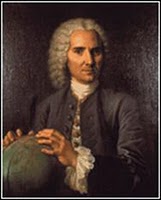The October March of Women, 1789
 Tuesday, October 6, 2009 at 9:29AM Tweet
Tuesday, October 6, 2009 at 9:29AM Tweet  " In the wee hours of October 6, 1789, a mob of peasant women broke into the Palace of Versailles. They had been encamped outside the chateau since the previous evening, awaiting an audience with my King, Louis XVI (16th), and his Queen, Marie Antoinette.
" In the wee hours of October 6, 1789, a mob of peasant women broke into the Palace of Versailles. They had been encamped outside the chateau since the previous evening, awaiting an audience with my King, Louis XVI (16th), and his Queen, Marie Antoinette.
The women had come from Paris and they were starving. Their children and their aged, as well, were starving. A terrible storm had wiped out France’s wheat crop that summer. Now the common folk had no bread, their main – and sometimes only – source of food. I followed them from Paris as they struggled to make the 20 kilometer journey on foot, afraid for my King, afraid of the power of the mob. As the women marched, their numbers grew. All along the route, I observed as more women dropped their washing and their brooms and left their children to join the fray. They arrived at Versailles in the thousands, demanding that King Louis and Marie Antoinette save them from their misery. Their hunger had driven them to madness. Waiting through the night for a response from the King had transformed their desperation to fury.
 Before dawn, the King and Queen were found with their two children and the King’s sister, Madame Elizabeth, huddled like mice before a gang of hungry cats, still in their bedclothes in the King’s private apartments. They were forced to dress quickly and pressed into waiting carriages bound for Paris, driven there by the mob so that they might bear witness to the misery of their subjects.
Before dawn, the King and Queen were found with their two children and the King’s sister, Madame Elizabeth, huddled like mice before a gang of hungry cats, still in their bedclothes in the King’s private apartments. They were forced to dress quickly and pressed into waiting carriages bound for Paris, driven there by the mob so that they might bear witness to the misery of their subjects. They would never see Versailles again.

I do not recall the moment I became conscious that I was powerless to save my King. But I do remember being gripped with the urgent imperative to save the King’s Garden. In a flash I knew, without thinking, that I, Antoine Laurent de Jussieu – the fourth member of my family to bear the title, Botanist-in-Chief to the King – was obliged to confront the mob to save the legacy of two centuries of adventurers and natural scientists, even if it meant my death.
The mob’s force was not diminished by its destruction of the chateau interior. The women’s anger only expanded with their ferocity, like a volcano whose vigor has been pent up for too long. And indeed, it did not take long for them to spill out into the Royal Gardens, intent on further rampage.
I was waiting for them. The botanists, master-gardeners, and under-gardeners of the Palace of Versailles were all waiting for them. We faced the mob armed only with the tools of our labors: shovels, spades, sickles and shears meant for pruning dead or dying leaves and branches from flowers and trees. We assembled to defend with our lives our life’s work: the plants and trees which for two hundred years had travelled to us from the far corners of the earth, and which we had so tenderly coaxed to adapt and thrive in the French soil and climate.
A woman with wrath in her eyes stepped out of the crowd. 'Move aside,' she bellowed. 'These gardens belong to the people, now.'

'Madam,' I said, taking a step forward as well. 'These gardens have always belonged to the people. They provide beauty for our pleasure as well as nourishment and medicine for our health. For 120 years, the products of the Versailles gardens have graced the King’s table and cured his ills. Destroy them and you destroy the means by which we may now help you to feed and care for your hungry children.'
An eerie hush fell upon the crowd. All that could be heard was the whisper of the pre-dawn winds through the trees and bushes of the vast gardens of Versailles. I gripped my ax; my heart raced as blood rushed to my pounding temples. It was the longest moment of my life.
'Long Live the King’s Garden!' someone shouted. 'Long Live the Garden of Plants!' cried another, changing the name of the garden to make it acceptable to the people. And then it grew, little by little until it was a resounding chorus: 'Vive le Jardin des Plantes! Long Live the Garden of Plants!'
And all at once, the chant shifted again. 'To Paris!' the women cried. And as they retreated, the gardens were flooded with the first light of a new dawn. The inheritance of two centuries of the blood and sweat of French plant hunters, botanists, and gardeners was saved, and it glowed in gratitude to those of us who had defended it."
*****
Excerpted from the Time Traveler Paris Tours: Long Live the King's Garden, by Sarah B. Towle (copyright 2009), expected launch date: March 2010.
Images:
Triumph of the Parisian Army and the People, from http://chnm.gmu.edu/revolution/d/230/.
Portrait of Antoine-Laurent de Jussieu, nephew of the de Jussieu brothers, Galerie des naturalistes de J. Pizzetta, Ed. Hennuyer, 1893, courtesy of Wikimedia Commons.











 Joseph
Joseph

